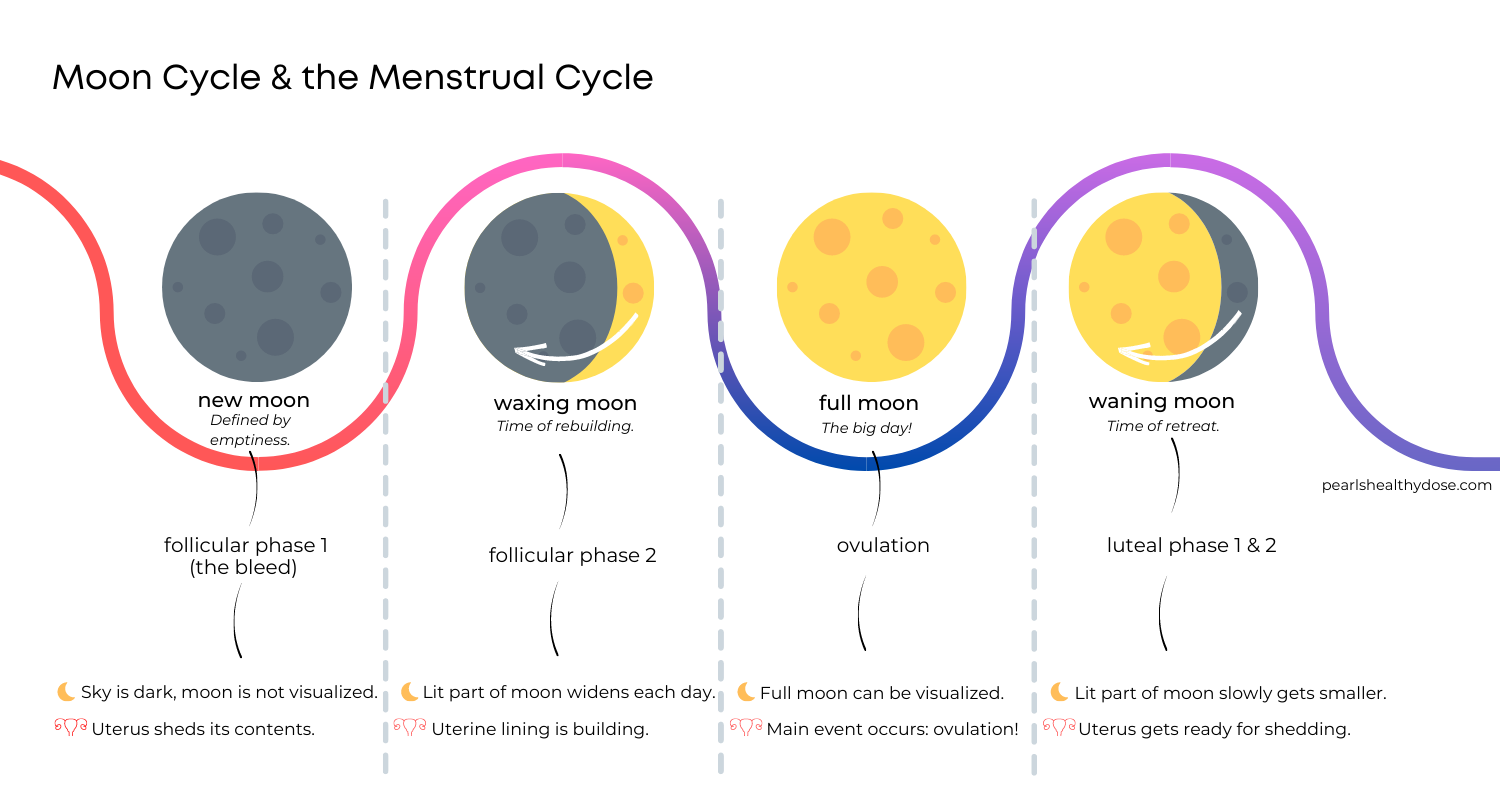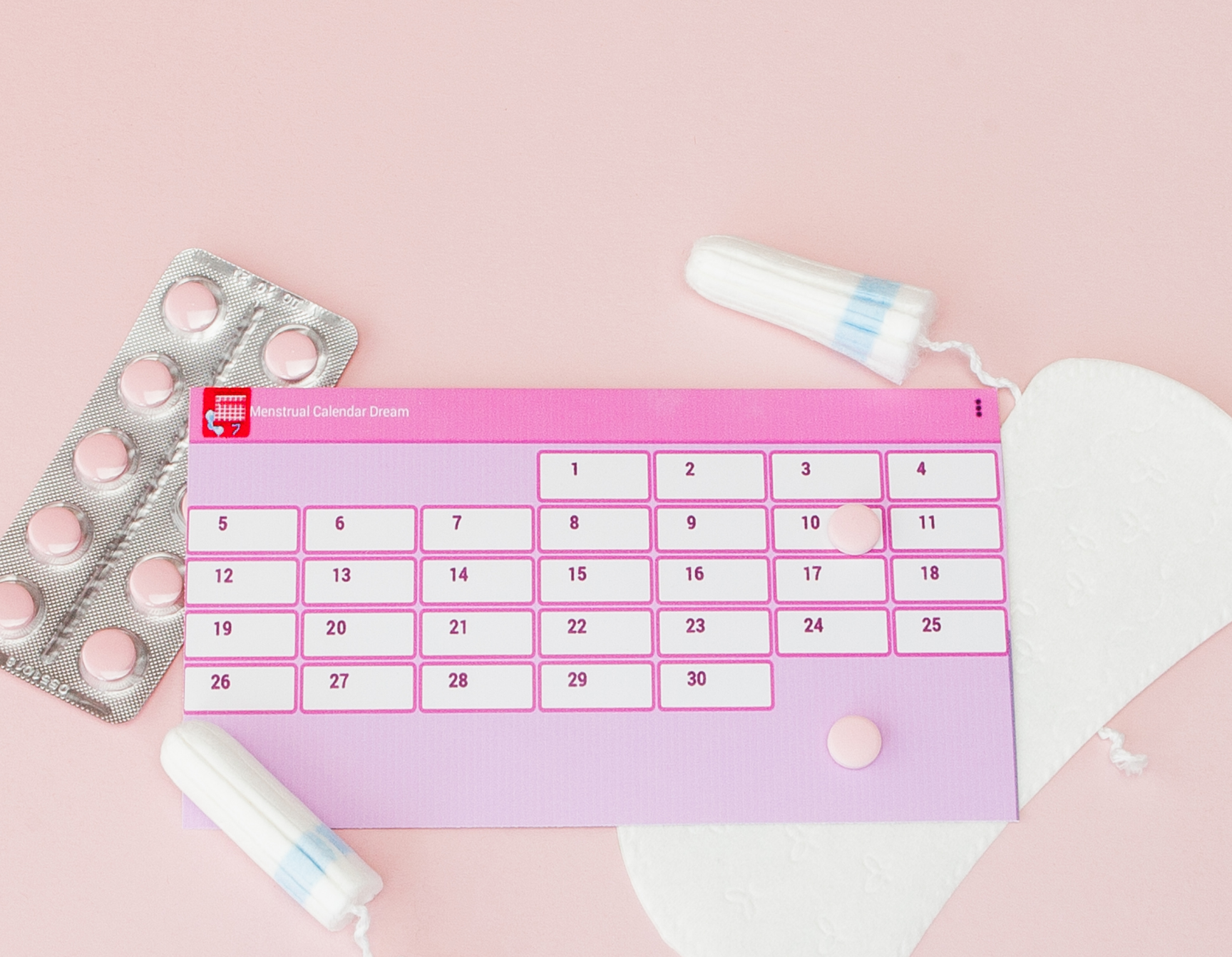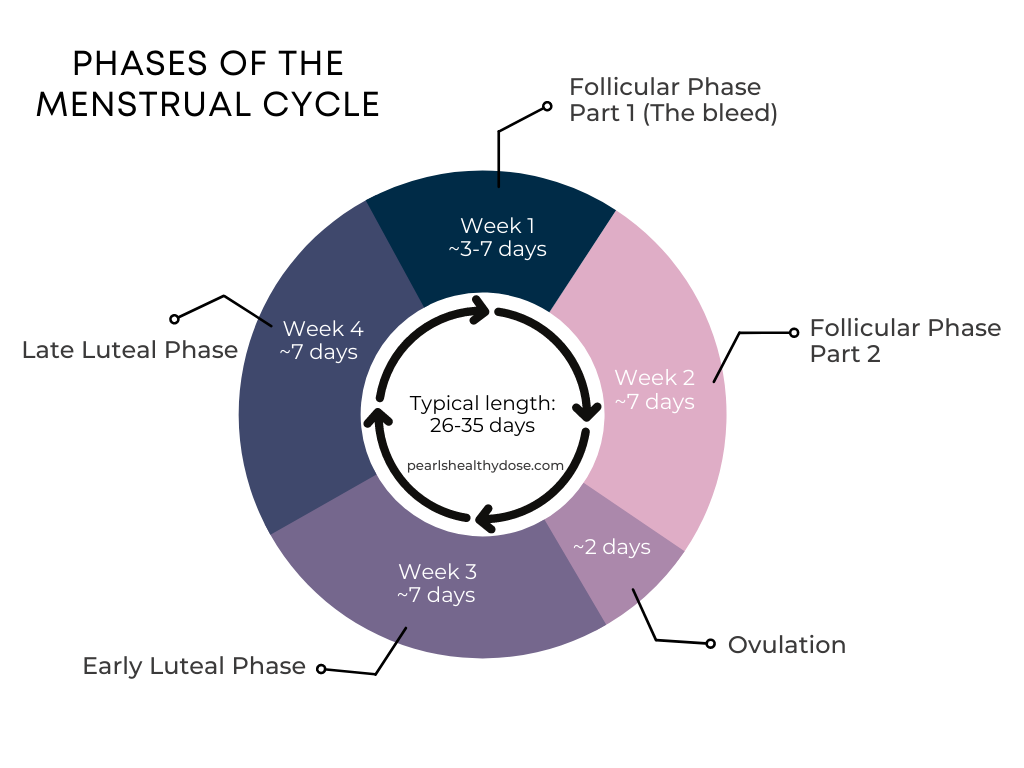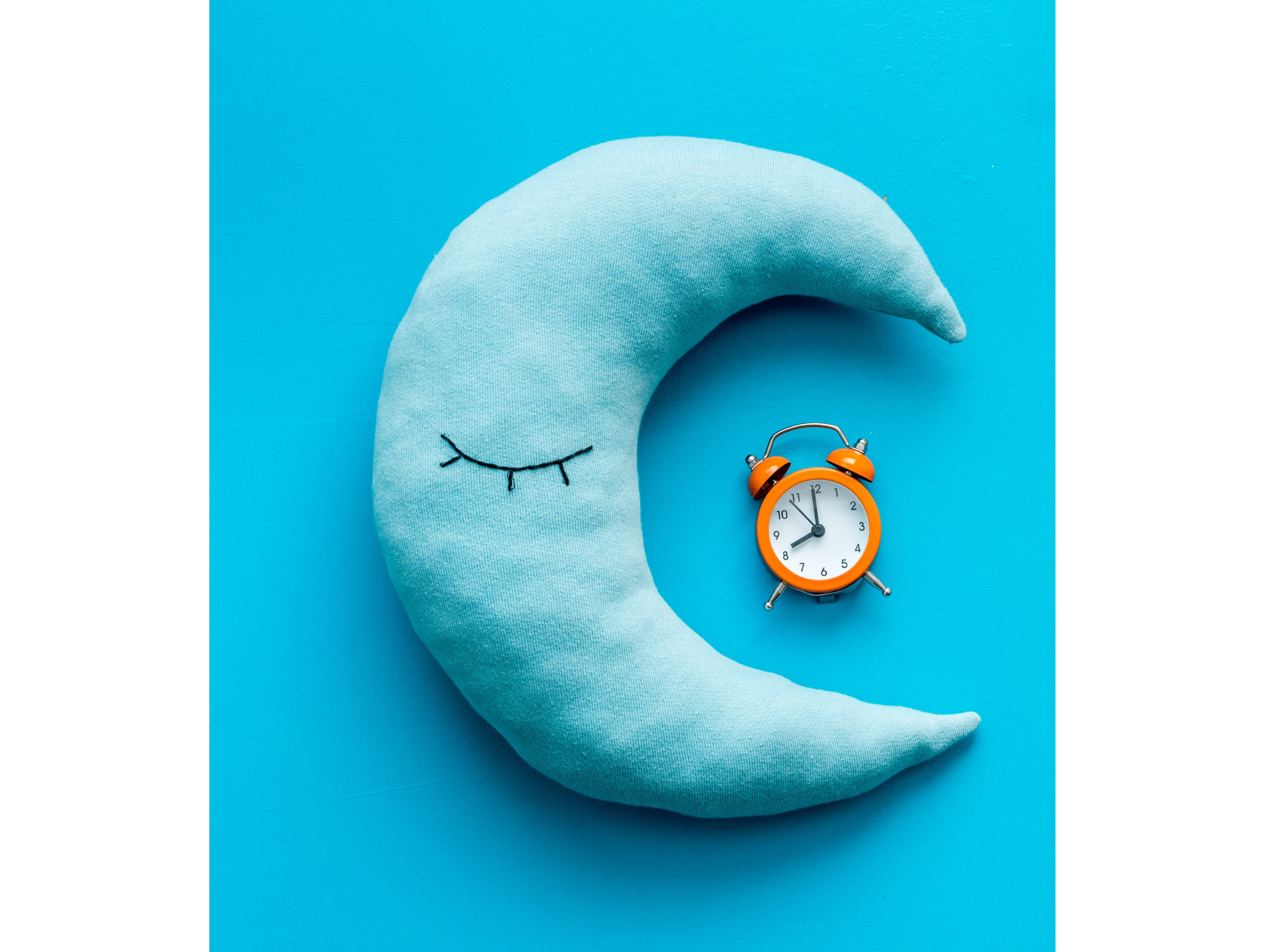During our reproductive years, women are cyclical beings in more ways than one. In addition to our 24-hour circadian rhythm, we have the ~26-35 day menstrual cycle. During this monthly cycle, hormones rise and fall, contributing to our different moods, symptoms and even exercise tolerance. Why is it that sometimes we feel like chatting with people nonstop and other times we just want to curl up in our jammies and stay in? Some days we are hitting PRs at the gym and other days, struggling just to get to the gym? Our hormones can have huge affects on how we feel day to day. Just as we can experience benefits when syncing with our circadian rhythm, there are numerous benefits to syncing with our menstrual cycle. I am excited to share this concept because I’ve experienced so many benefits myself!
Benefits of Cycle Syncing:
- Reduced stress, physically and mentally
- Increased productivity
- Feeling happier and better in your body
- Build muscle, lose fat
- Better periods with less PMS
- Increased energy
- Show up as a better version of yourself!
The Cycle Schedule
To fully understand our menstrual cycle, let’s look at what exactly is going on. It is divided into two main phases: follicular phase and luteal phase.
The follicular phase begins when the endometrial lining is shed and we get our period. Although it is typically 3-7 days long, for simplicity we can consider this Week 1. During Week 2, follicles in the ovaries continue to mature (hence “follicular phase”) until a dominant follicle releases an egg – POP!
After ovulation (release of the egg) occurs, the luteal phase starts. Here in Week 3, our bodies focus on building the endometrial lining in the uterus. If the egg is not fertilized, hormones fall in the 2nd half of the luteal phase during Week 4. This results in our period and the follicular phase begins once again.
Putting It Together
While we can visualize our cycle as being divided into 4 weeks, a “week” may be longer or shorter and may blend into the next. This is why we need to listen to our bodies as our hormones change. It may change month to month and be affected by stressors, such as lack of sleep. Also, dividing the cycle into 4 weeks assumes a 28-day cycle. However, women have different cycle lengths, usually ranging from 26 to 35 days. Of note, the luteal phase (time post ovulation until the period) is typically the same number of days for each woman. Since our cycles are different, tune in as much as possible to customize to your body. The best way to keep track of the days is to download a cycle tracking app. There are lots out there!
What if I’m on the pill or other hormonal birth control?
Using hormonal birth control will suppress your body’s natural cycle, eliminating the natural ups and downs of our different hormones. As such, our bodies do not go through the phases mentioned above. The bleed that occurs is a “withdrawal bleed,” which is not the same as a natural bleed. Many of us take birth control to manage PMS, but these symptoms are actually our bodies communicating with us. Rather than chemically eliminating the symptoms, we can manage it through lifestyle factors such as diet, exercise, and stress reduction to give our bodies what it is looking for. With all that said, you certainly can still cycle sync, but the hormonally driven inclinations (and super powers!) may not be so present.
What if I do not have a cycle?
Females who are post menopause, post baby, or who have irregular cycles can sync with the moon cycle. The moon cycle has phases that represent phases of our menstrual cycle. In fact, it is thought that our natural rhythm is to be synced with the moon cycle!

- New moon = Follicular Phase 1 (the bleed)
- Waxing moon = Follicular Phase 2
- Full moon = Ovulation
- Waning moon (longest phase) = Luteal Phase 1 & 2
Using This Guide:
The key to syncing with your cycle is paying attention and listening to your body. Do what you feel like doing.
Categories under each phase:
- Hormones – what they are doing this week
- Mood/Interests– how you’re feeling, what to do for syncing
- Exercise – how to best work out for where you are in the cycle
- Food – what to eat to support your body for each phase
Avoid things that will cloud your judgement, such as:
- Lack of sleep. Sleep needs to be a priority.
- Sugary and “carby” foods that will spike your blood sugar, which will then plummet and make you feel tired, groggy and irritable. Examples are bread, pasta, candy, chips, and other processed foods.
Exercise Tips:
- If you feel tired or exhausted rather than energized after a workout, take note! You may have exercised too hard.
- Only exercise after you’ve had enough sleep and feel well rested. Otherwise, opt for a lighter activity such as going for a walk or stretching.
- Keep it personalized. A workout should be suited to be within your exercise ability. Keeping workouts harmonized to your body, you’ll feel stronger and be able to do more with time.
- Avoid high intensity workouts before bedtime. Exercising at least 3 hrs before bedtime will help ensure better sleep.
- If your hormones are unbalanced (ie – cycles not regular, moderate-severe PMS), consider limiting exercise by doing the following. The key here is to not go too hard and overstress the body.
- Keep heart rate under 180 – Age. Example: Max Heart Rate = 180 – 37 years old = 143 bpm.
- Limit workouts to 30 minutes.
- If you’re concerned that you should be working out rather than resting, remember that relaxation can decrease cortisol and lead to weight loss.

| Follicular Phase, Part 1 (The Bleed) |
|---|
| Week 1 (~Days 1-7 of menstrual cycle) |
| Hormones Estrogen and progesterone are at their lowest point. |
| Mood/Interests The period is our trigger to do some self care and pampering. As women, we are often so outwardly focused on others. This phase is a built-in reminder to take care of ourselves. It will restore our energy and allow us to show up as our best self. During this phase, our energy may be lower, especially with heavier bleeding. There is also increased interest in spending time alone. This is a good time for self reflection, planning, meditation and journaling. Give yourself a break and treat yourself! Plan a mani/pedi, make time for a relaxing bath, or do something you want to do for yourself. |
| Exercise Studies have shown a general reduction in exercise performance during this time and a greater propensity for injury, especially in the first two days. Therefore, it would be wise to take it easy, especially in the beginning. Rather than a workout, you may choose to spend time reading, meditating, or napping (no guilt!). Otherwise, going for a walk, light yoga and stretching are also great options. What’s important is that you are listening to what your mind and body wants. Later in this phase, based on energy levels, you may be up for light to moderate resistance workouts or cardio. |
| Food This is a good time to initiate a healthy diet as our cravings are typically lower (post that PMS phase). Additionally, it is important to nourish your body during your period. Eat soups and stews made with bone broth. Make sure to incorporate iron rich and nutritious foods, such as: beets, pumpkin/flax/chia seeds, leafy greens, grass-fed beef, pasture-raised eggs, and seafood. Avoid aggravating exhaustion by keeping blood sugar level, eating whole foods and limiting sugar, bread, pasta, cookies and processed foods in general. |

| Follicular Phase, Part 2 |
|---|
| Week 2 (~Days 8-14 of menstrual cycle) |
| Hormones Estrogen begins to rise and will peak at the end of this phase, helping to trigger ovulation. Testosterone also continues to rise during this week. |
| Mood/Interests Hello, social butterfly, flirty vixen, conqueror of the world! During this phase, we tend to feel more social, have an increased sex drive (thanks, testosterone!), and posess more energy. We feel motivated and creative. This is also a good time to start a new diet, as our cravings are at bay, and to try something new. It’s an ideal time to schedule events and social gatherings. Here is when our speech tends to be on point and we’re better at getting thoughts across. During this phase, estrogen is involved in sharpening our cognitive function, plumping our skin, and (research has shown) making us look more attractive! Ooh! |
| Exercise Make it count! This is the time to hit that PR. With testosterone rising, it’s prime time for building muscle and burning fat. As estrogen is also rising during this phase, we experience reduced fatigue, improved muscle recovery and higher pain tolerance. This is a time where higher volume can be tolerated during weight training, as well as more intense cardio. Time to shine! However, be careful towards the end of this phase when estrogen peaks (those couple days prior to ovulation). Estrogen makes our ligaments more lax and may make us more prone to injury, especially with explosive movements such as those incorporated in HIIT workouts (ie – jump squats/lunges, burpees). Instead, consider (heavy) weight training or steady state cardio during the last couple days. |
| Food Make sure you are getting plenty of protein, especially if you’re exercising more and trying to build muscle. Help your body manage the increasing estrogen by eating plenty of vegetables, especially in the cruciferous category including broccoli, cauliflower, cabbage, brussels sprouts, bok choy, arugula and kale. Fermented foods such as kimchi, sauerkraut, and yogurt (no sugar added please!) and/or probiotics are helpful too. Our diet is a key factor in the metabolism and disposal of estrogen, which moderates PMS symptoms later in the cycle. |

Typically estimated to be around Day 14, ovulation occurs over a ~24 hour period. When estrogen peaks, it prompts LH (luteinizing hormone) to spike, triggering release of the egg. Many women feel amazing during this time. Others may experience painful ovulation with cramping and an increase in acne (hello, excess estrogen!) Tailor your day around how you’re feeling. It may take a few cycles of symptom tracking (maybe also cervical fluid tracking) to pinpoint this time, or you can use ovulation tests that measure LH hormone to estimate ovulation timing.

| Luteal Phase, Part 1 (“Early Luteal Phase”) |
|---|
| Week 3 (~Days 15-21 of menstrual cycle) |
| Hormones Post ovulation, the main player progesterone rises dramatically. Estrogen will decline and rise slightly again before plummeting with menstruation. Testosterone also starts to decline post ovulation. |
| Mood/Interests Ride on that post follicular phase high! In the beginning, our energy level, social interest, and other ‘perks’ of the last phase are still present. As this phase progresses and the rise of progesterone exerts its effects, we start going into our “nesting” phase. You may know that progesterone also reigns during pregnancy – it makes us want to organize the closet/pantry and get things done! Therefore, it’s the perfect time to hunker down and finish that project you’ve been working on. |
| Exercise A major factor in this phase is the increase in basal body temperature that occurs post ovulation. As expected, this makes it easier for us to feel hot, tired, sweaty and uncomfortable during workouts. Progesterone may make us feel fatigued easier and make it harder to recover, especially after high intensity workouts. The luteal phase is known as the more catabolic state. As such, it as an opportune time for “burning fat.” Conversely, the previous follicular phase is the more anabolic state where we can focus on building muscle (making use of that testosterone!) Additionally, with the increased cortisol during this phase, we want to limit overstressing our bodies to effectively limit fat storage. Decrease intensity of workouts by allowing more breaks between sets, cutting workouts short, keeping heart rate lower and decreasing weights. Ideal exercises here are resistance training with moderate weights, intense yoga, light runs and pilates. |
| Food Especially in the first few days, the increase in body temperature may make you crave ‘cooling’ foods such as smoothies and salads. Go for it! Just make sure to limit fruits in your smoothie (it will spike your blood sugar) or make it a veggie smoothie instead. The rise in progesterone increases our cravings, especially for highly palatable snack foods. I allow myself more leeway here. After all, our body is accomplishing a big task during this phase. It is building our endometrium, the lining in our uterus. In fact, our metabolism increases during this phase. I like to increase my starch intake here to curb cravings, but balance it with plenty of fat and protein. Sweet potatoes are a great starchy source, with the added benefit of being nutrient dense. Progesterone also slows down digestion, so beware of constipation. Combat this by maintaining adequate hydration and eating plenty of vegetables (= fiber) to keep things moving! As in the previous phase (and always if you can), prevent upcoming PMS by eating plenty of cruciferous vegetables such as broccoli, cauliflower, cabbage, brussels sprouts, bok choy, arugula and kale. Additionally, try to limit alcohol consumption. This will protect the liver to let your body clear those extra estrogens and manage PMS. |

| Luteal Phase, Part 2 (“Late Luteal Phase”) |
|---|
| Week 4 (~Days 22-28 of menstrual cycle) |
| Hormones Estrogen and progesterone both decline. This phase is when symptoms of hormone imbalance (and therefore PMS) would present itself. The most common hormone imbalance is estrogen dominance. This may involve solely the estrogen level being high. Alternatively, we may have a high estrogen level relative to our progesterone level due to low progesterone. |
| Mood/Interests During this phase, especially with hormone imbalance, we may experience PMS symptoms such as mood swings, acne, bloating, breast tenderness and headaches. Additionally, since progesterone promotes relaxation and sleepiness, having low progesterone can cause symptoms of anxiety and difficulty sleeping. It could also cause “weird poops” (ie – loose stools) during the end of this phase as it’s responsible for balancing the prostaglandins that stimulate our uterine lining to shed. The extra prostaglandins may also exert its effects on our lungs, so those of us with reactive airway disease or asthma may experience more symptoms. In general, we are in a more inflamed state during this phase, creating a greater likelihood of autoimmune flare. With all this being said, keeping hormones balanced would limit PMS symptoms, allowing for a much more comfortable (ideally symptomless!) week prior to the period. |
| Exercise Follow your mood! Intensity will likely depend on whether symptoms of PMS are present. When experiencing PMS, we may prefer lighter workouts such as yoga, stretching, or walking. With mild or no PMS, we may be comfortable continuing moderate intensity workouts. Remember, cortisol is higher during the luteal phase so make sure to limit intensity. Especially in this phase, I limit workouts to 30 minutes and keep my heart rate under 180-age. |
| Food Prevent mood swings by keeping blood sugar balanced. Continue eating a diet with plenty of fiber, with focus on cruciferous vegetables. Healthy fats such as those from avocados, olive oil, nuts and seeds, will also help maintain stable blood sugar and prevent those “hangry” scenarios. Of note, these healthy fats are essential for hormone production, especially progesterone. In terms of protein, eat wild caught fish, free range poultry and grass fed beef to reap the most benefit and limit inflammation. |
The Takeaway
Our moods and how we feel physically are ways in which our bodies communicate with us. Tuning in and listening can allow us to reap the benefits of giving our bodies and minds what it needs. In terms of cycle syncing, knowing where we are in our cycle can help us make everyday decisions that support and take advantage of our hormones. Understanding why we feel the way we do leads to greater satisfaction, increased happiness, and decreased stress. There is so much to gain from cycle syncing. If you are not doing it already, I hope you give it a try!
Resources and Sources of Inspiration:
Books:
In the FLO: Unlock Your Hormonal Advantage and Revolutionize Your Life by Alisa Vitti
Beyond the Pill: A 30-Day Program to Balance Your Hormones, Reclaim Your Body, and Reverse the Dangerous Side Effects of the Birth Control Pill by Dr. Jolene Brighten
The Betty Body: A Geeky Goddess’ Guide to Intuitive Eating, Balanced Hormones, and Transformative Sex by Dr. Stephanie Estima
Apps supporting cycle syncing:
FitrWoman – focused on exercise and training
My Flo – paid app, created by author of In the FLO
Additional Resources:
This post is written for informational purposes only and does not constitute professional medical advice, diagnosis or treatment.




